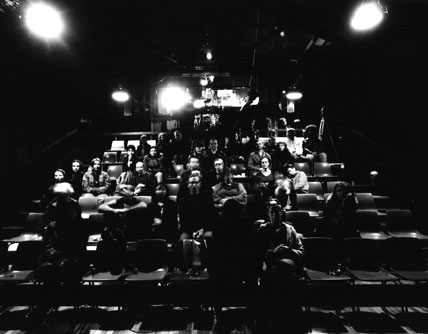| |
The audience is seated in the theatre. The performer enters the space and places a large
format camera on the stage facing the audience. He informs them that tonight's performance will take up four minutes of their time. The audience is instructed to stare at the camera and remain perfectly still for a period of four minutes. The lights are dimmed and the cameras shutter is opened. The performer exits the space leaving the audience and camera locked in a mutual gaze for the duration of the four minute exposure. He then re enters the space and closes the shutter terminating the exposure. The audience is then asked to vacate the premises.
In the incrimination of light Part III, the subjects become temporary objects . Even before the image becomes imprinted onto the negative the audience's actions pre-empt their fate. The curse/blessing of any moment captured by the lens is immobility eternal. For the period of four minutes the audience (performers) and camera are locked within the photographic space. The corporeal struggle of the living body within that space becomes evident in the stillness, as opposed to movement, of the audience (performers). Sontag proposes that one of "photography's promises was to democratise all experience by turning them into images." The four minute exposure attempts this by recording the whole event on the negative. The camera which usually "captures" a fragment and the essence of the event is questioned. The four minute exposure expands the frozen moment, gradually recording layers of time that constitutes the event onto the negative. The resulting image is not just a document, it is the duration and outcome of the action. The photograph is the event!
Within this frame there exists a dilemma where the image no longer rests comfortably in the captured photographic context. The blurring of the subjects through the long exposure, questions the photographic capture. Through movement, identity is lost and the subject evades the abduction that is the photograph. If light incriminates, time may restore freedom.
< | >
|
|

The incrimination of light (part III)
Performance / photograph
2006 |